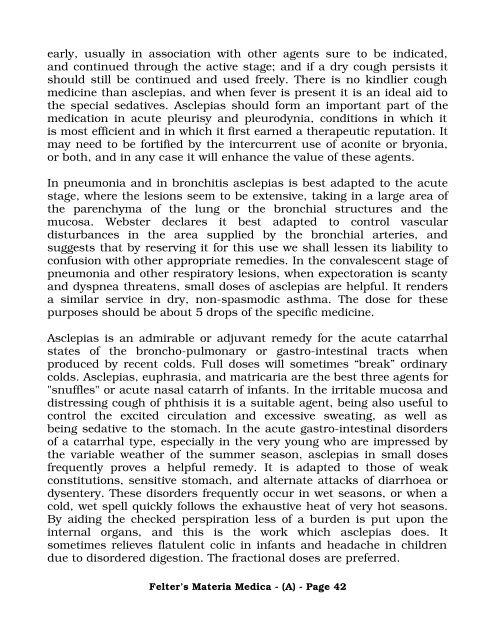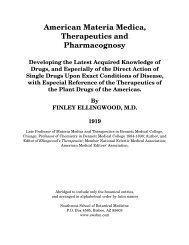Individual Drugs. ABIES (Tsuga canadensis). - Southwest School of ...
Individual Drugs. ABIES (Tsuga canadensis). - Southwest School of ...
Individual Drugs. ABIES (Tsuga canadensis). - Southwest School of ...
You also want an ePaper? Increase the reach of your titles
YUMPU automatically turns print PDFs into web optimized ePapers that Google loves.
early, usually in association with other agents sure to be indicated,<br />
and continued through the active stage; and if a dry cough persists it<br />
should still be continued and used freely. There is no kindlier cough<br />
medicine than asclepias, and when fever is present it is an ideal aid to<br />
the special sedatives. Asclepias should form an important part <strong>of</strong> the<br />
medication in acute pleurisy and pleurodynia, conditions in which it<br />
is most efficient and in which it first earned a therapeutic reputation. It<br />
may need to be fortified by the intercurrent use <strong>of</strong> aconite or bryonia,<br />
or both, and in any case it will enhance the value <strong>of</strong> these agents.<br />
In pneumonia and in bronchitis asclepias is best adapted to the acute<br />
stage, where the lesions seem to be extensive, taking in a large area <strong>of</strong><br />
the parenchyma <strong>of</strong> the lung or the bronchial structures and the<br />
mucosa. Webster declares it best adapted to control vascular<br />
disturbances in the area supplied by the bronchial arteries, and<br />
suggests that by reserving it for this use we shall lessen its liability to<br />
confusion with other appropriate remedies. In the convalescent stage <strong>of</strong><br />
pneumonia and other respiratory lesions, when expectoration is scanty<br />
and dyspnea threatens, small doses <strong>of</strong> asclepias are helpful. It renders<br />
a similar service in dry, non-spasmodic asthma. The dose for these<br />
purposes should be about 5 drops <strong>of</strong> the specific medicine.<br />
Asclepias is an admirable or adjuvant remedy for the acute catarrhal<br />
states <strong>of</strong> the broncho-pulmonary or gastro-intestinal tracts when<br />
produced by recent colds. Full doses will sometimes “break” ordinary<br />
colds. Asclepias, euphrasia, and matricaria are the best three agents for<br />
"snuffles" or acute nasal catarrh <strong>of</strong> infants. In the irritable mucosa and<br />
distressing cough <strong>of</strong> phthisis it is a suitable agent, being also useful to<br />
control the excited circulation and excessive sweating, as well as<br />
being sedative to the stomach. In the acute gastro-intestinal disorders<br />
<strong>of</strong> a catarrhal type, especially in the very young who are impressed by<br />
the variable weather <strong>of</strong> the summer season, asclepias in small doses<br />
frequently proves a helpful remedy. It is adapted to those <strong>of</strong> weak<br />
constitutions, sensitive stomach, and alternate attacks <strong>of</strong> diarrhoea or<br />
dysentery. These disorders frequently occur in wet seasons, or when a<br />
cold, wet spell quickly follows the exhaustive heat <strong>of</strong> very hot seasons.<br />
By aiding the checked perspiration less <strong>of</strong> a burden is put upon the<br />
internal organs, and this is the work which asclepias does. It<br />
sometimes relieves flatulent colic in infants and headache in children<br />
due to disordered digestion. The fractional doses are preferred.<br />
Felter’s Materia Medica - (A) - Page 42
















